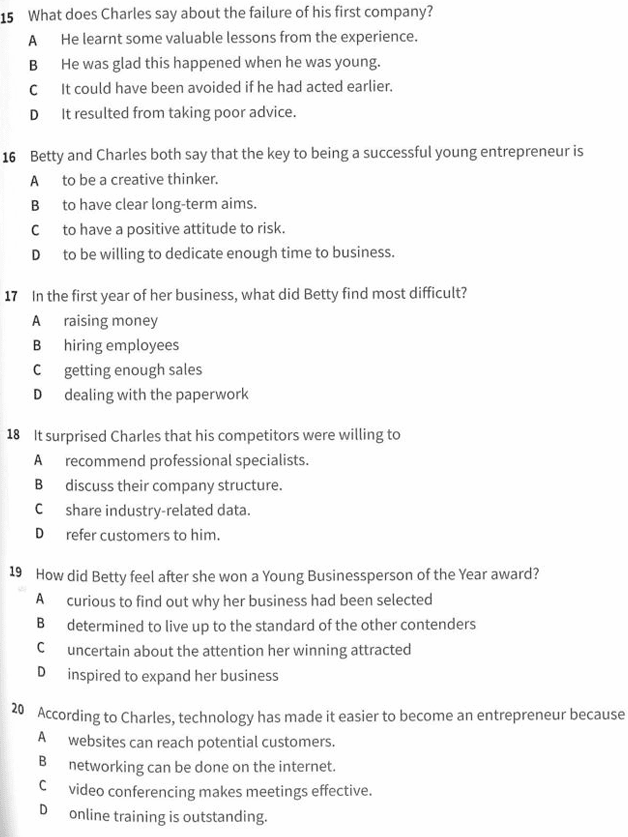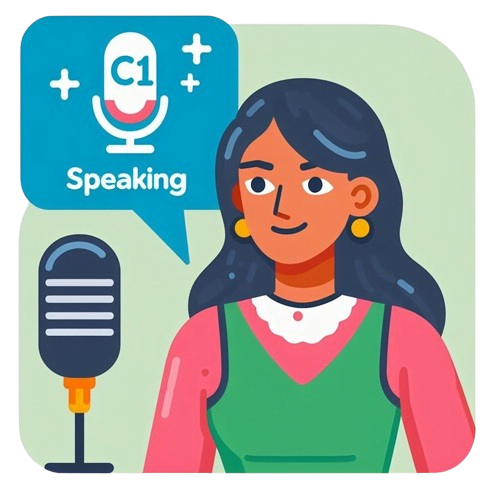Cambridge C1 Advanced (CAE) Listening Part 3
What you will find in this guide:
Cambridge C1 (CAE) Listening Part 3
The Listening Part 3 of the Cambridge C1 Advanced (CAE) gives you comprehension questions to answer. You must listen to the track very carefully and answer multiple choice questions based on what you hear. Listening Part 3 has a total of 6 questions from questions 15 to 20 and each correct answer earns candidates 1 mark.
Sample Question
You will hear an interview in which two journalists called Jenny Langdon and Peter Sharples are talking about their work. For questions 15 – 20, choose the answer (A, B, C or D) which fits best according to what you hear.
Audio
Questions
15. What does Jenny say about the story which made her name?
A. She’d been on the lookout for just such a lucky break.
B. She resented colleagues trying to take the credit for it.
C. She wasn’t actually responsible for the finished article.
D. She asked for a more prestigious job on the strength of it.
16. What does Jenny suggest about the editor she worked for on her first national daily
newspaper?
A. He respected her for standing up to him.
B. He tended to blame her for things unfairly.
C. He wasn’t as unreasonable as everyone says.
D. He taught her the value of constructive criticism.
17. When Jenny got her own daily column on the newspaper, she felt
A. satisfied that the good work she’d done elsewhere had been recognised.
B. relieved that it was only likely to be a short-term appointment.
C. determined to prove exactly what she was capable of.
D. unsure of her ability to make a success of it.
18. Peter thinks he got a job on Carp Magazine thanks to
A. his academic achievements at college.
B. his practical knowledge of everyday journalism.
C. his familiarity with the interests of its main target audience.
D. his understanding of how best to present himself at interview.
19. Peter and Jenny agree that courses in journalism
A. need to be supplemented by first-hand experience.
B. are attractive because they lead to paid employment.
C. are of little value compared to working on a student newspaper.
D. provide an opportunity for writers to address contentious issues.
20. When asked about their novels, Peter and Jenny reveal
A. an ambition to gain recognition for their craft.
B. a desire to develop careers outside journalism.
C. a need to prove how versatile they are as writers.
D. a wish to keep their journalism fresh and appealing.
Potential Challenges
Part 3 in the Listening paper in Cambridge C1 Advanced (CAE) could be challenging due to the following factors:
- Too Much Information: In this part, you will listen to two people speaking about a topic for a longer period of time and they will give you a lot of information about a topic. Processing all that information may be a bit difficult.
- Fast Delivery! This part involves a lot of information but also that information is delivered to you at the speed of light! So, you may miss some part of the information if you are not focused.
- Confusing Answer Choices: The speakers often talk about all the topics mentioned in all the answer choices A,B, or C. So you may feel overwhelmed by that.
- Inferring and Making a Decision: Most proficiency tests require you to infer from a text you just read or a conversation you just listened to to answer a question. This means that you not only need to be proficient in the English language but also need to have good critical thinking and inference skills.
Guide to Cambridge C1 (CAE) Listening Part 3
Step 1: Identify the keywords of the questions and answer choices.
Keywords are the words that are most important or carry the most significant meaning in each answer choice or question. By identifying the keywords, you can quickly focus on the relevant information.
Step 2: If you still have time, read the questions and items carefully before you listen to the audio.
Step 3: Focus on the keywords as you listen to the audio.
Once you listen to the audio, listen for keywords you identified earlier. This way you won’t get lost in the audio. Once you hear the keyword or a synonym of it, focus on the meaning and try to identify the answer, which can be found either in the idea introduced before or after the keyword.
Step 4: Eliminate two options that are obviously wrong.
Based on your understanding of the idea, eliminate the answer choices that are obviously wrong. This will help you narrow down your choices and increase your chances of getting the right answer.
Step 5: Choose between the remaining two options.
Finally, use your logic and reasoning skills to choose between the remaining two options. Look for evidence in the content you listened to that supports or contradicts each option. Choose the option that best matches what is stated or implied in the audio. In this step, you need to focus on implied message as well as what was directly stated. In many cases, the answer is not directly stated but implied through a similar statement.
Note 1: The information will generally be presented in the order of the questions. If you miss a piece of information, forget about it and move on to the next item. You will have another opportunity to catch it when the audio is replayed.
Note 2: Be very cautious of the synonyms and distractors. The audio introduces the ideas through synonyms so you have to be very diligent. Also, the speaker may use a word that seems to be the answer but later change the idea using a negative word that negates the idea introduced earlier. This is called a distractor, which you will regularly find in Cambridge listening tracks.
Practice Test
Use the guide to answer the same question.
You will hear an interview in which two entrepreneurs, called Charles and Betty, are talking about their experience of setting up a business when they were young. For questions 15 – 20, choose the answer (A, B, C or D) which fits best according to what you hear.
Question

How was your experience?
Describe your experience taking the part 3 listening question in the comment section below.
You may also check out my guides for the other parts of The Cambridge C1 Advanced (CAE) Listening Test:







This part is difficult because the audio is long and I feel a bit, also the questions sometimes confuse me.
It was difficult because the speaker says the correct answer but with other words and we get lost.
Everything is difficult in this part, specially that question that ask if people are agree.
My experience was really bad since I got the answers but I don’t know how. I will give these steps a try!
It’s difficult because in the audio we listen a lot of information, so we need to filter the important info to solve every question